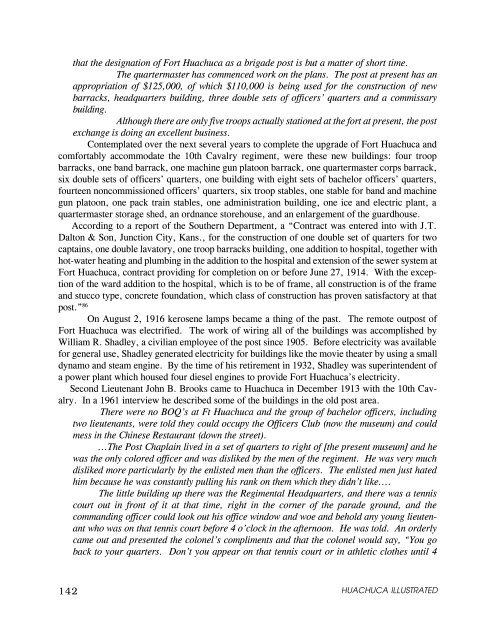Turn of the Century - Fort Huachuca - U.S. Army
Turn of the Century - Fort Huachuca - U.S. Army
Turn of the Century - Fort Huachuca - U.S. Army
- No tags were found...
You also want an ePaper? Increase the reach of your titles
YUMPU automatically turns print PDFs into web optimized ePapers that Google loves.
that <strong>the</strong> designation <strong>of</strong> <strong>Fort</strong> <strong>Huachuca</strong> as a brigade post is but a matter <strong>of</strong> short time.The quartermaster has commenced work on <strong>the</strong> plans. The post at present has anappropriation <strong>of</strong> $125,000, <strong>of</strong> which $110,000 is being used for <strong>the</strong> construction <strong>of</strong> newbarracks, headquarters building, three double sets <strong>of</strong> <strong>of</strong>ficers’ quarters and a commissarybuilding.Although <strong>the</strong>re are only five troops actually stationed at <strong>the</strong> fort at present, <strong>the</strong> postexchange is doing an excellent business.Contemplated over <strong>the</strong> next several years to complete <strong>the</strong> upgrade <strong>of</strong> <strong>Fort</strong> <strong>Huachuca</strong> andcomfortably accommodate <strong>the</strong> 10th Cavalry regiment, were <strong>the</strong>se new buildings: four troopbarracks, one band barrack, one machine gun platoon barrack, one quartermaster corps barrack,six double sets <strong>of</strong> <strong>of</strong>ficers’ quarters, one building with eight sets <strong>of</strong> bachelor <strong>of</strong>ficers’ quarters,fourteen noncommissioned <strong>of</strong>ficers’ quarters, six troop stables, one stable for band and machinegun platoon, one pack train stables, one administration building, one ice and electric plant, aquartermaster storage shed, an ordnance storehouse, and an enlargement <strong>of</strong> <strong>the</strong> guardhouse.According to a report <strong>of</strong> <strong>the</strong> Sou<strong>the</strong>rn Department, a “Contract was entered into with J.T.Dalton & Son, Junction City, Kans., for <strong>the</strong> construction <strong>of</strong> one double set <strong>of</strong> quarters for twocaptains, one double lavatory, one troop barracks building, one addition to hospital, toge<strong>the</strong>r withhot-water heating and plumbing in <strong>the</strong> addition to <strong>the</strong> hospital and extension <strong>of</strong> <strong>the</strong> sewer system at<strong>Fort</strong> <strong>Huachuca</strong>, contract providing for completion on or before June 27, 1914. With <strong>the</strong> exception<strong>of</strong> <strong>the</strong> ward addition to <strong>the</strong> hospital, which is to be <strong>of</strong> frame, all construction is <strong>of</strong> <strong>the</strong> frameand stucco type, concrete foundation, which class <strong>of</strong> construction has proven satisfactory at thatpost.” 86 On August 2, 1916 kerosene lamps became a thing <strong>of</strong> <strong>the</strong> past. The remote outpost <strong>of</strong><strong>Fort</strong> <strong>Huachuca</strong> was electrified. The work <strong>of</strong> wiring all <strong>of</strong> <strong>the</strong> buildings was accomplished byWilliam R. Shadley, a civilian employee <strong>of</strong> <strong>the</strong> post since 1905. Before electricity was availablefor general use, Shadley generated electricity for buildings like <strong>the</strong> movie <strong>the</strong>ater by using a smalldynamo and steam engine. By <strong>the</strong> time <strong>of</strong> his retirement in 1932, Shadley was superintendent <strong>of</strong>a power plant which housed four diesel engines to provide <strong>Fort</strong> <strong>Huachuca</strong>’s electricity.Second Lieutenant John B. Brooks came to <strong>Huachuca</strong> in December 1913 with <strong>the</strong> 10th Cavalry.In a 1961 interview he described some <strong>of</strong> <strong>the</strong> buildings in <strong>the</strong> old post area.There were no BOQ’s at Ft <strong>Huachuca</strong> and <strong>the</strong> group <strong>of</strong> bachelor <strong>of</strong>ficers, includingtwo lieutenants, were told <strong>the</strong>y could occupy <strong>the</strong> Officers Club (now <strong>the</strong> museum) and couldmess in <strong>the</strong> Chinese Restaurant (down <strong>the</strong> street)....The Post Chaplain lived in a set <strong>of</strong> quarters to right <strong>of</strong> [<strong>the</strong> present museum] and hewas <strong>the</strong> only colored <strong>of</strong>ficer and was disliked by <strong>the</strong> men <strong>of</strong> <strong>the</strong> regiment. He was very muchdisliked more particularly by <strong>the</strong> enlisted men than <strong>the</strong> <strong>of</strong>ficers. The enlisted men just hatedhim because he was constantly pulling his rank on <strong>the</strong>m which <strong>the</strong>y didn’t like....The little building up <strong>the</strong>re was <strong>the</strong> Regimental Headquarters, and <strong>the</strong>re was a tenniscourt out in front <strong>of</strong> it at that time, right in <strong>the</strong> corner <strong>of</strong> <strong>the</strong> parade ground, and <strong>the</strong>commanding <strong>of</strong>ficer could look out his <strong>of</strong>fice window and woe and behold any young lieutenantwho was on that tennis court before 4 o’clock in <strong>the</strong> afternoon. He was told. An orderlycame out and presented <strong>the</strong> colonel’s compliments and that <strong>the</strong> colonel would say, “You goback to your quarters. Don’t you appear on that tennis court or in athletic clo<strong>the</strong>s until 4142 HUACHUCA ILLUSTRATED
















